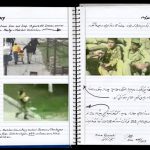Insomnia
Duration: 7’:08”
Year: 2010
This is a video installation / video art
The Insomnia project comprises three series; paintings, drawings and a video piece. The subject matter which relates these pieces is simultaneously simple and complicated; leading to multiple layers of meaning though seeming easy to grasp at the first glance. Insomnia is a psycho-somatic disorder identified with having difficulties with getting to/or having enough sleep. This is also closely related to one’s general physical and psychological state. Therefore, this is not unlikely for the viewer to associate the pieces with psychological and psychoanalytic concerns. However, a major part of these psychological malfunctioning is altogether a result of external factors, namely a psycho-sociological structure in which the artist has lived and now represents her lived experience.
If art is to be considered as functioning inside a cultural chain, which in turn may be studied through artistic creation, then art is a meaningful phenomenon responding through its diverse forms to multiple conscious and subconscious contextual issues. These responses, though indirect and ambiguous, nevertheless, consists its core subjective construction.
Psychoanalysis of artistic creation defines art as being “perceptive”, which means it may be studied through questions regarding perceptions. This series – as noticeable in the ambiguity of the title – refers to a malfunctioning. What lies behind this malfunctioning is itself another question which Keramati poses through her narration of the subject, addressing broader issues she has experienced. The multilayered character of this concept which relies on viewer’s “perception” is visible in all parts of the series. The faces cannot be identified neither in colourful paintings nor in monochrome drawings – all representing different poses of insomniac figures’ heads. This leaves the viewer with a mere repetition of the state of restlessness associated with insomnia. This hesitant, problematic state of in-betweenness culminates in the video piece, which resonates with the perception also included in the title.
The unusual large format paintings represent a rather repetitive motif – particularly as all the figures are female – a repetition of anguish and distress intentionally arranged to redirect the viewer’s perception into the distressed, tormented condition of insomnia.
Unlike the brightly coloured canvases, the video is black and white. It begins with an audio-visual semi-abstraction: a white, translucent curtain against the white, cloudy sky. The curtain starts moving with the wind, once covering and then unraveling the view of the sky. However, the sky remains gloomy, leaving the viewer awaiting something uncertain. The ambiguity of the image is increased by the slow mode of display, giving the image a quality between reality and dream similar to the moment of getting into sleep or the very experience of insomnia. It seems that these moments are never to come to an end.
The vague sounds of the video are the effects of a typical afternoon in the city (Tehran), a combination of the sound of cars, motorcycles, continuous horns, and occasional bird sounds. The slow speed of the sound play reminds the resonation of sounds and images while between wake and sleep. Some carefully selected phrases from Virginia Woolf’s The Waves accompany the images and contribute to the development of more layers of meaning. The selected phrases, although matching with the artist’s mind, remain loyal to the poetic character of Woolf’s writing. Woolf’s more symbolic, multilayered phrases, and the juxtaposition of the words resonate the objective of the project:
I look at the rook’s high nest; and the pear tree.
“His eyes will see when mine are shut”
I think.
Written by Dr. Hamid Keshmirshekan
Translated to English by Helia Darabi
Catalogue of the solo exhibition in Etemad Gallery, Tehran, 2010







